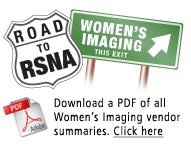Women's imaging has had a wild ride this year, with controversy over computer-aided detection (CAD) and excitement over new technology -- particularly the further development of breast MRI. This November's Radiological Society of North America (RSNA) meeting will reflect that energy, as vendors show off works-in-progress and highlight upgrades intended to improve images and catch hard-to-find lesions.

Yet controversy or no, CAD is definitely still a player in the women's imaging game: Other studies this year found that the technology may improve the accuracy of radiologists in distinguishing malignant breast masses from benign masses on 3D volumetric ultrasound images, and that CAD may improve the breast cancer detection rate for full-field digital mammography and film-screen mammography in facilities that use double reading. At the RSNA meeting, look for new combinations of digital imaging with CAD, such as computed radiography.
Another key theme in women's imaging this year has been how best to detect ductal carcinoma in situ (DCIS). Which modality is most effective? MRI? Mammography? Breast-specific gamma imaging?
Since the last RSNA meeting, feedback has been contradictory: The American Cancer Society recommended against the routine use of MR for women with DCIS, while researchers at George Washington University presented clinical results at the American Roentgen Ray Society meeting that claim that breast-specific gamma imaging beats both MR and mammography paddles-down. But like CAD, MRI is definitely still generating intense interest, particularly high-resolution, high-contrast MRI.
Finally, RSNA attendees will find plenty of new technologies in the spotlight this year, such as real-time continuous ultrasound elastography, which can help identify malignant breast lesions and divert some patients with suspicious masses from biopsy; automated whole-breast ultrasound; ultrasound tomography for breast cancer screening, which uses water as a conductor between a ring-shaped transducer and the breast tissue; optical imaging; and dedicated breast CT, to name a few.



















